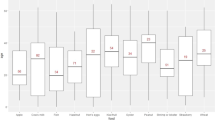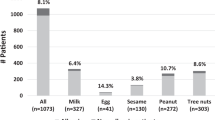Abstract
Objective: To describe the frequency and epidemiological features of self-reported food hypersensitivity in Portuguese adults.
Design: Cross-sectional.
Setting: Participants were selected by random digit dialing among residents of Porto.
Subjects: In total, 659 individuals over 39 y were asked to recall the occurrence of food hypersensitivity, and to describe the most serious episode. The adoption of eviction diets and previous medical diagnosis of food allergy were recorded, and recent dietary intake was evaluated using a validated food frequency questionnaire.
Results: Self-reported food allergy was more frequent in women than men (7.3 vs 1.9%, P<0.01) and decreased with age. Age- and sex-standardized (European population ≥40 y) prevalence of food hypersensitivity was 4.8% (95% CI 3.4–6.9%). Most subjects (67.6%) referred allergy to a single food, fresh fruits being the more frequently incriminated (25%). Approximately 90% that reported food allergy declared the adoption of eviction diets, although 53% in fact ingested the incriminated foods during the previous year.
Conclusions: The adult prevalence of food hypersensitivity in Porto is one of the lowest observed worldwide, probably reflecting specificities of the genetic make-up and dietary patterns of our population.
This is a preview of subscription content, access via your institution
Access options
Subscribe to this journal
Receive 12 print issues and online access
$259.00 per year
only $21.58 per issue
Buy this article
- Purchase on Springer Link
- Instant access to full article PDF
Prices may be subject to local taxes which are calculated during checkout
Similar content being viewed by others
References
Altman D & Chiaramonte L (1996): Public perception of food allergy. J. Allergy Clin. Immunol. 97, 1247–1251.
Bjornsson E, Janson C, Plaschke P, Norrman E & Sjoberg O (1996): Prevalence of sensitization to food allergens in adult Swedes. Ann. Allergy Asthma Immunol. 77, 327–332.
Bousquet J, Metcalfe D & Warner J (1997): Food allergy: position paper of the codex alimentarius. ACI Internacional, 9/1.
Castillo R, Delgado J, Quiralte J, Blanco C & Carrillo T (1996): Food hypersensitivity among adult patients: epidemiological and clinical aspects. Allergol. Immunopathol. 24, 93–97.
Cuesta-Herranz J, Lazaro M, Martinez A, Figueredo E, Palácios R, de las Heras M & Martinez J (1999): Pollen allergy in peach – allergic patients: sensitization and cross-reactivity to taxonomically unrelated pollens. J. Allergy Clin. Immunol. 104, 688–694.
Dean AG, Dean JA, Coulombier D, Brendel KA, Smith DC, Burton AH, Dicker RC, Sullivan K, Fagan RF & Arner TG (1996): Epi Info, version 6.04c: a word processing, database, and statistics for epidemiology in microcomputers. Centers for Disease Control and Prevention, Atlanta, USA. World Health Organization, Geneva, Switzerland.
European Allergy White Paper (1998): Allergic Diseases as a Public Health Problem ed Moerbeke D Brussels: The UCB Institute of Allergy.
Jansen J, Kaardinaal A, Huijbers G, Vlieg-Boerstra B, Martens B & Ockhuizen T (1994): Prevalence of food allergy and intolerance in the adult Dutch population. J. Allergy Clin. Immunol. 93, 446–456.
Kanny G, Moneret–Vautrin D, Flabbee J, Beaudouin E, Morisset M & Thevenin F (2001): Population study of food allergy in France. J. Allergy Clin. Immunol. 108 (Part 1), 133–140.
Last MJ (1995): A Dictionary of Epidemiology, 3rd edn. Oxford: International Epidemiological Association, Inc. Oxford University Press.
Lopes C (2000): Alimentação e enfarte agudo do miocárdio. PhD Thesis. Porto, Portugal:University of Porto Medical School.
Molkhou P (2000): Food Allergies. Present and Future Problems. Brussels: The UCB Institute of Allergy.
Moneret-Vautrin D (1998): Les allergenes alimentaires et leurs modifications par les technologies agro-alimentaires. Rev. Fr. Allergol. 37, 21–28.
Moneret-Vautrin D (2003): The allergic risk of transgenic foods strategy for prevention. Ann. Pharm. Fr. 61, 92–106.
Moneret-Vautrin D & Kanny G (1995): L’anaphylaxie alimentaire. Nouvelle enquête multicentrique française. Bull. Acad. Natl. Med. 179, 161–184.
Ortolani C, Bruijnzeel-Koomen C, Bengtsson U, Bindslev-Jensen C, Bjorksten B, Host A, Ispano M, Jarish R, Madsen C, Nekam K, Paganelli R, Poulsen LK & Wuthrich B (1999): Controversial aspects of adverse reactions to food. European Academy of Allergology and Clinical Immunology (EAACI) Reactions to Food Subcommittee. Allergy 54, 27–45.
Ramos E, Lopes C & Barros H (2004): Investigating the effect of non-participation using a population based case–control study on myocardial infarction. Ann. Epidemiol. doi:10.1016/i.annepidem.2003.09.013.
Rance F (2000): Current childhood food allergies. Allerg. Immunol. (Paris) 32, 366–376.
Schäfer T, Böhler E, Ruhdorfer S, Weigl L, Wessner D, Heinrich J, Filipiak B, Wichmann HE & Ring J (2001): Epidemiology of food allergy/food intolerance in adults: association with other manifestation of atopy. Allergy 56, 1172–1179.
Sloan A & Powers M (1986): A perspective on popular perceptions of adverse reactions to foods. J. Allergy Clin. Immunol. 78, 127–133.
Wantke F, Gotz M & Jarisch R (1993): Histamine-free diet: treatment of choice for histamine-induced food intolerance supporting treatment for chronic headaches. Clin. Exp. Allergy 23, 982–985.
Werfel T (2001): Skin manifestation in food allergy. Allergy 56 (Suppl 67), 98–101.
Woods R, Abramson M, Bailey M & Walters E (2001): International prevalences of reported food allergies and intolerances. Comparisons arising from the European Community Respiratory Health Survey (ECRHS) 1991–1994. Eur. J. Clin. Nutr. 55, 298–304.
Woods R, Stoney RM, Raven J, Walters EH, Abramson M & Thien FCK (2002): Reported adverse food reactions overestimate true food allergy in the community. Eur. J. Clin. Nutr. 56, 31–36.
Young E, Stoneham M, Petruckevitch A, Barton J & Rana R (1994): A population study of food intolerance. Lancet 343, 1127–1130.
Acknowledgements
This investigation was partially funded by FCT—Fundação para a Ciência e a Tecnologia (Praxis 2/2.1/SAU/1332/95 and 35769/99). Nuno Lunet gratefully acknowledges a Grant from Fundação para a Ciência e a Tecnologia (SFRH/BD/3293/2000).
Author information
Authors and Affiliations
Corresponding author
Rights and permissions
About this article
Cite this article
Falcão, H., Lunet, N., Lopes, C. et al. Food hypersensitivity in Portuguese adults. Eur J Clin Nutr 58, 1621–1625 (2004). https://doi.org/10.1038/sj.ejcn.1602017
Received:
Revised:
Accepted:
Published:
Issue Date:
DOI: https://doi.org/10.1038/sj.ejcn.1602017
Keywords
This article is cited by
-
Food hypersensitivity: an examination of factors influencing symptoms and temporal changes in the prevalence of sensitization in an adult sample
European Journal of Clinical Nutrition (2023)
-
Prevalence and clinical features of adverse food reactions in Portuguese children
Allergy, Asthma & Clinical Immunology (2017)
-
Prevalence and clinical features of adverse food reactions in Portuguese adults
Allergy, Asthma & Clinical Immunology (2016)
-
Identification of European Allergy Patterns to the Allergen Families PR-10, LTP, and Profilin from Rosaceae Fruits
Clinical Reviews in Allergy & Immunology (2011)
-
Epidemiologie der Nahrungsmittelallergie in Europa
Ernährung - Wissenschaft und Praxis (2008)



